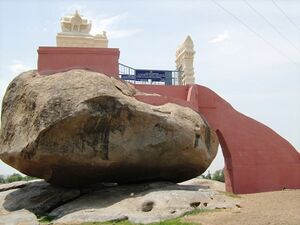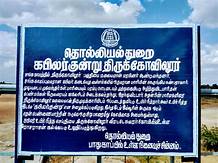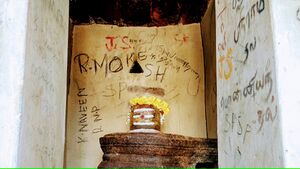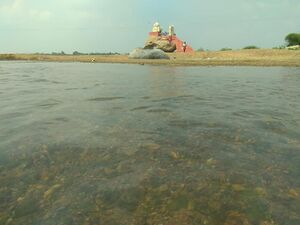Kabilar Rock
இந்தப் பக்கத்தை தமிழில் வாசிக்க: கபிலர் குன்று
Kabilar Rock (Kabilar Kundru) is a hill rock located at the place where Kabilar was believed to have breathed last. Kabilar Rock is located at Tirukoilur in Viluppuram district. A stone inscription there mentions that Kabilar died here and hence a rock Kabilakkal is here on his memory (See Kabilar).
Location
Tirukoilur is located at a distance of about 40 km from Viluppuram. This hill rock is situated in the center of Thenpennai river near the Veerattaneswarar temple, which is 2 km from the bus stand. This hill rock is a small rock placed on top of another rock. This hill rock has a very small temple built on top of it.
Temple Structure
Built of bricks and stucco, the temple dates back to 14th century C.E and it has a Shivalinga installed within it. This temple is considered to be Kabilar's Pallipadai (Sepulchral temple) as there was a custom of installing a Shivalinga in the Pallipadai of those who die after renunciation. According to the researchers, there might have been only a Linga on the hill rock for a long time and the temple got constructed at a later date.
On top of the temple are two male figures and two female figures along with divine sculptures. The female figures are considered to be Angavai and Sangavai, while the male figures are considered to be Kabilar and Malayamman. Kabilar Rock is under the control of Tamil Nadu State Department of Archaeology.
History
The territory with the capital of present day of Tirukoilur in the Viluppuram district, was known as Maladu as well as Malayamman Nadu. This territory was ruled by the Malayammans. Their hill was called as Mullur. Malayamman Thirumudikari, a king, was one of the Kadayezhu Vallalgal. Kabilar composed songs on Malayamman Thirumudikari (Purananuru 121, 122, 123, 124). The mother of Rajaraja Chola I belonged to the Malayamman dynasty. Malayammans were also the army commanders of Rajaraja and Rajendra cholas.
After Velpari was killed by the Muvendars (triumvirate of Chera, Chola and Pandya kings who ruled the ancient Tamil territory), Kabilar who was friend of Velpari tried to get his daughters married off to the kings like Irunkovel and approached them. When they refused, after handing over Velpari daughters to Andhanars (definition per ancient Tamil: one who lives upholding moral values and ethics), Kabilar sacrificed his life by Vadakiruthal (fasting unto death facing north) (Purananuru 236).
The Tirukoilur inscription, which is believed to be dated to 13th century C.E., mentions that Kabilar married off Pari's daughters to Tirukoilur Malayamman and proceeded for immolating himself in the fire and sacrificed his life. Researchers note that this place was afterwards recognized as Kabilakkal.
This shrine was declared as an archaeological monument through G.O. No. 80/Ta.Va.Pa. Department/Dated/17.01.85, and is considered as Kabilar memorial place.
Kovalur Puranam
When there was a renaissance during 15th century C.E. in Tamil kingdom after the decline of the art and culture during the 14th century C.E., a new story was written for Kabilakkal on mythological basis. Kovalur Puranam titled Kabilacharukkam (Kabilar Chapter) was composed. This Puranam states that Kabilan, an ascetic, worshipped a Linga by placing it on a rock in the Pennaiyar river in Tirukoilur to remove his difficulties, and then he attained liberation (Sivanadi - feet of Lord Shiva).
There is a painting about Kovalur Puranam which was done 150 years earlier to writing this Puranam. This was painted on Tirukoilur gopuram canopy. In one of the paintings, Sage Kabilar is seen worshipping a Linga in a small temple on a rock in Pennaiyar river. Below it, there is a reference to Kabilacharukkam in Tamil. Next to it, there is a painting of Avvaiyar worshipping Lord Ganesha for Pari's daughters wedding. And there are several other Kovalur mythological scenes.
In Kovalur Puranam’s divine king story, Pari is depicted as the Sinhala king. There is also a note that, after the death of Pari, Avvaiyar married off Pari’s daughters Angavai and Sangavai to Deivigan, the king of Tirukoilur. It is understood that there was a temple on Kabilakkal in Tirukoilur from 15th century C.E. to end of 19th century C.E. and the Linga in it was named as Kabileswarar.
Tirukoilur Stone Inscription
An inscription from the time of Rajaraja Chola I on the northern wall of the sanctum sanctorum of the Veerattaneswarar temple at Tirukoilur mentions the below:
"Senchor kabilan murivan thadakkai
Parithannadaikalap pennai malayarkuthavi
Minalpugum visumbin veeduperenni
Anthariksham sela kanalpugum pennai
Alaipunal azhuvathu kabilak kallathu"
References
- Kabilar Kundru, Department of Archaeology
- Kabilakal, Kudavayil Balasubramanian, varalaaru.com
- Kabilar Kundru, India temple tour
- Kabilar Kundru video
⨮ Standardised-en
Please do not write any content below this line. This section is only for editing templates & categories.




